12 Awesome New Vive Demos We Played

The Rift is going to have a hard time matching this launch lineup
I had the chance to attend Valve’s Steam VR Developer Showcase on Wednesday, where I got to play 12 upcoming titles for the Vive. Most of the games in the gallery ahead will actually be ready at launch in April; the other titles are expected to release in the months soon thereafter. It's worth mentioning that these games aren’t necessarily the only titles that will be available at launch, but are simply the titles that Valve has hand-selected to show off at the event.
In case you aren’t too familiar with what makes the Vive unique compared to other VR systems, it supports room-scale tracking, which means you’ll be able to walk around your virtual environment. The Vive also ships with VR controllers. These two sticks will be able to replicate anything from a gun to a golf club. In short, they offer 1:1 tracking and are super awesome.
Anyways, let’s get onto the demos!
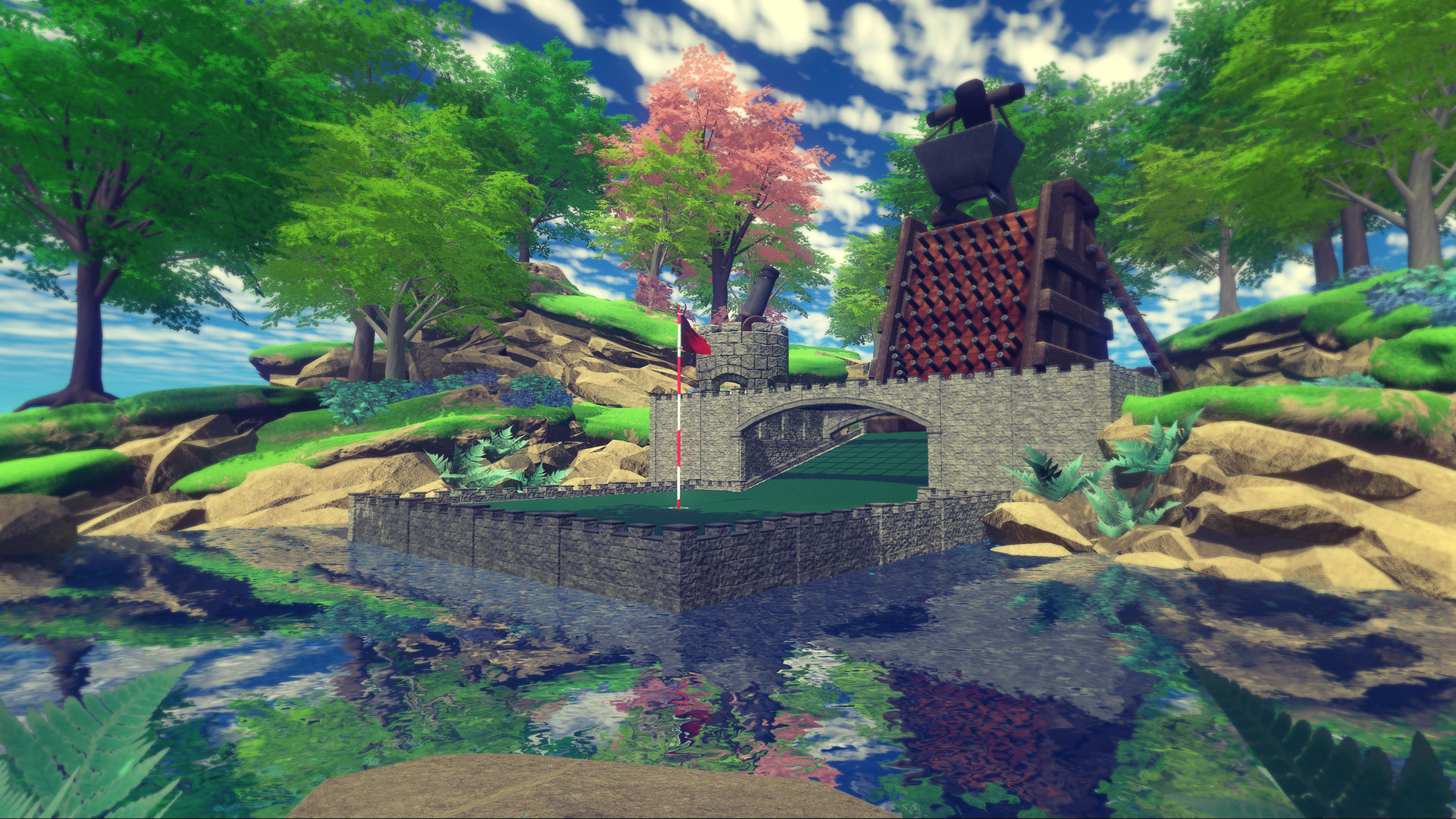
Cloudlands: VR Minigolf
Have you ever wanted to play mini golf within the confines of your home? Well, now you can with Futuretown’s Cloudlands: VR Minigolf. The game has a very bright and colorful aesthetic and works as well as you would expect it to. You use one VR controller as a golf club, and after you swing and hit the ball, you press a button on the controller to teleport to where the ball stops. The physics here are quite accurate; so, if you’re good at mini golf, you’ll probably do pretty well. Conversely, if you suck at the sport, you’ll probably suck here, too.
Using the Unity engine, the developers had to go to the mini golf range multiple times to fine tune the mechanics. The end result is that it really feels like you’re at a mini golf course. The game will have 18 holes at launch, with the developer likely adding more as DLC. While 18 holes sounds a bit limited, the devs are also playing around with the idea of adding a level editor.
While the levels in the game are great, they're a bit conventional and take place in castle-like environments and feature old European architecture. One of my suggestions for them is to go zany with the environments, and let you play mini golf in space with alien backgrounds, etc.
As it stands, the game will be ready for the Vive’s launch and is a great fit for VR. I could see it becoming the Vive’s Wii Sports, if you will, with the family gathering around the TV and taking turns at trying to get the best score.
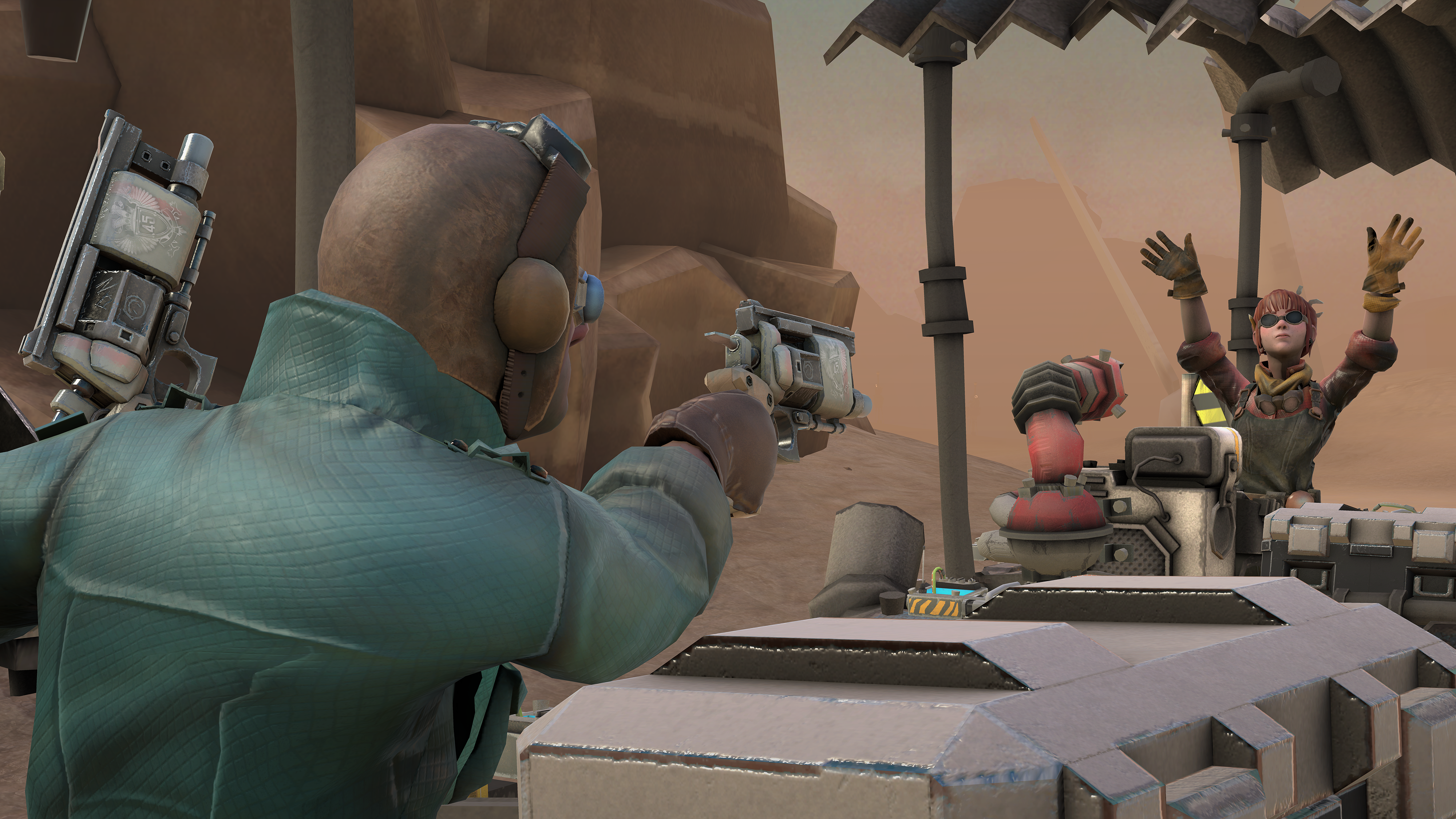
Hover Junkers
Hover Junkers was the only multiplayer demo we played at the event. Developed by Stress Level Zero, it's a first-person shooter that, as the name of the game implies, allows you to hover around the environment and collect junk. You’re basically on a little ship and you float around a Mad Max-like desert picking up scrap to use as barricades for your vehicle.
I ended up playing the game against two of the developers. We each had our own ship and were tasked with obliterating each other. Because you can pick up scrap and fortify your ship, it’s actually important to use the Vive’s room-scale feature to duck and cover behind your ship’s defenses as you shoot. Shooting is fun and we had two guns to choose from. One was a revolver and when you run out of bullets, you press down on one of the controllers buttons so that your chamber opens up. From here, you use the controller’s circular pad to perform an “iPod-like shuffle movement” to reload the gun. Then you just flick the gun sideways and the chamber pops back in so that you’re locked and loaded again. While it seems simple enough, you actually have to develop a muscle memory for it to become second nature. The developers designed it as such because they want to make the game more strategic and tactical, rather than making it a shooting spam fest. The other gun we got to use was a shotgun. Reloading here was a little more simple. You simply press a button to open up the barrels, and reload the gun one bullet at a time with a button press (the shotgun takes up to three bullets at a time). If you’re right-handed like me, you can use your left hand to steer the hovercraft while you shoot your enemies with your right hand.
While the game will focus heavily on multiplayer (and the devs said they were heavily influenced by Goldeneye 64’s multiplayer), Hover Junkers will also have a single-player campaign that will offer several hours of gameplay as well. Regardless of its length in the end, it’s definitely a fun, social shooting game that we can’t wait to get our hands on.

Tilt Brush
We’ve tried out Tilt Brush a few times before, but it never seems to get old. If Oculus’ Medium app is like sculpting in 3D, than Tilt Brush is like sketching in 3D. With the controller in my right hand, I press down on the trigger to begin drawing squiggly lines in the air in front of me. With the other controller in my left hand, I can rotate tools and change brush color, size, texture, and more. Tilt Brush also allows you to change the background you’re drawing in. Want to sketch in space with the stars surrounding you? No problem. Tilt Brush also allows you to take 2D snapshots of your artwork to share with others, and you can save your 3D artwork and share it with other people who have the Vive, and they can see in a speedy time-lapse fashion how you created your work. On our unit, we looked through a dozen or so sketches, some of which include artwork from legendary Disney artist Glen Keane, whose work you can see in this amazing video.
Acquired by Google, Tilt Brush will be ready at the Vive’s launch.
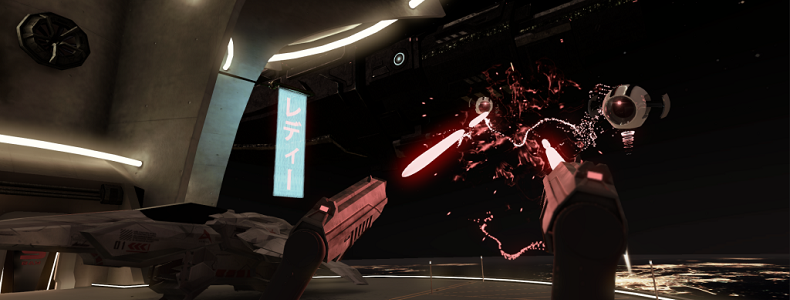
Space Pirate Trainer
While you might not realize it at first, Space Pirate Trainer by I-Illusions is a modern VR adaptation of Galaga. In the first-person shooter demo we played, the devs tossed us into a sci-fi space hanger and had us defending our docked spaceship from flying, attacking robots. We were armed with a pair of rapid-fire laser pistols and shields, and could mix and match between the two. I found that going with one shield on my left hand and one blaster on my right hand worked best for me. The shield is vital since three enemy blasts takes you out and you have to fight your way from the first wave of robots once you die.
As mentioned, it's a wave-based game that gets harder with each wave and the robots do have a certain pattern to figure out. We personally got stuck on wave seven and heard that the farthest anyone’s gotten that day was wave nine. Apparently, the highest level the dev could get to was wave 12.
What really makes Space Pirate Trainer unique is that 1) you feel kind of like Boba Fett on a space hanger with your blaster and 2) the game really forces you to almost run around your room to dodge enemy laser blasts. Sure, other games take advantage of room scale, but you really have to be mobile here to truly succeed at the game. This is arguably its biggest strength and biggest weakness, considering there is a cable on the floor you have to contend with. Still, considering the game isn’t coming out at launch, the folks over at I-Illusions still have time to work out the kinks.
While the game only took place in one environment with a limited number of weapons, the devs did tell me that more weapons are to come, and the environments will likely be more dynamic in the final game. Regardless, if you’re looking for a fun, sci-fi shooting gallery that will make you feel like Boba Fett, Space Pirate Trainer is one to look out for.
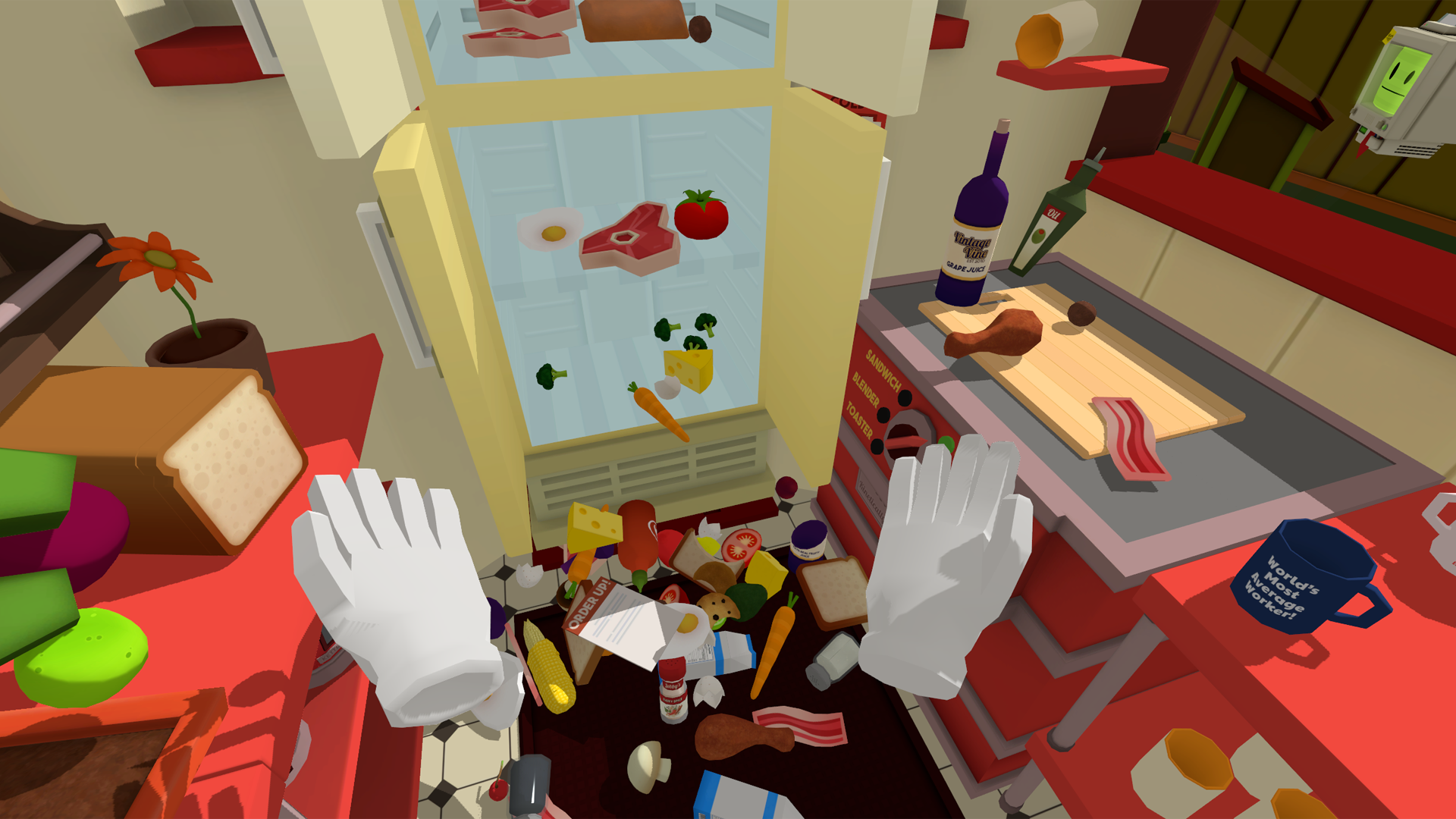
Job Simulator: The 2050 Archives
Job Simulator is a game we’ve tried out before in the past, but developer Owlchemy Labs has made several improvements to the title since we played it at its GDC 2015 unveiling.
The premise for the game is fun and quirky. The year is 2050 and robots now do all the work that people used to do. There are essentially no jobs left for mankind. As a result, there are job archives that kids from the future can visit to see what it was like when humans had to work. The robots at this archive then throw you into a job simulator so you can see what it was like to work at a convenience store or in an office “back in the olden days.” Our particular demo took us to a virtual kitchen as a chef. Here, the simulator tasked us with cooking up some orders. Our first order, had us frying up some bacon and eggs, for instance. This meant we had to walk around a kitchen to find ingredients, and to turn on the stove to cook them. It's worth mentioning that the original kitchen Owlchemy Labs showed off at GDC 2015 has been completely reworked. Now, the fridge can transform into a cabinet with the press of a button or a stove can transform to a grill with the pull of a lever. This transforming kitchen makes sense within this futuristic and goofy setting, but the developers primarily implemented it because they know most users at home won’t have access to a giant walkable area. It’s a very smart tactic that turns a weakness into a strength.
It's also worth mentioning that there are no time metrics here, so you’re free to roam around the kitchen and play with pots and pans as you please. One order had us freestyling our own soup recipe, for instance, so we decided to add some milk and cookies to our savory soup, because... why not? After we got done making soup, we looked in our pot to find that it had magically turned itself into a soup can. While the robots are pretty good at their jobs, they can’t quite encapsulate 100 percent what it means to be a chef from a human’s perspective. This layer of oddity adds a fun charm to the game.
There will be five different jobs within Job Simulator when the game releases, which will be at the Vive's launch. One concern I've heard is that you’ll be able to breeze through the game pretty quickly, but Owlchemy Labs says that they have implemented a ton of easter eggs for you to find, and that the game is at its best when you approach it at a leisurely pace, taking time to goof off. Regardless of replayability, Job Simulator was a highlight of the event.
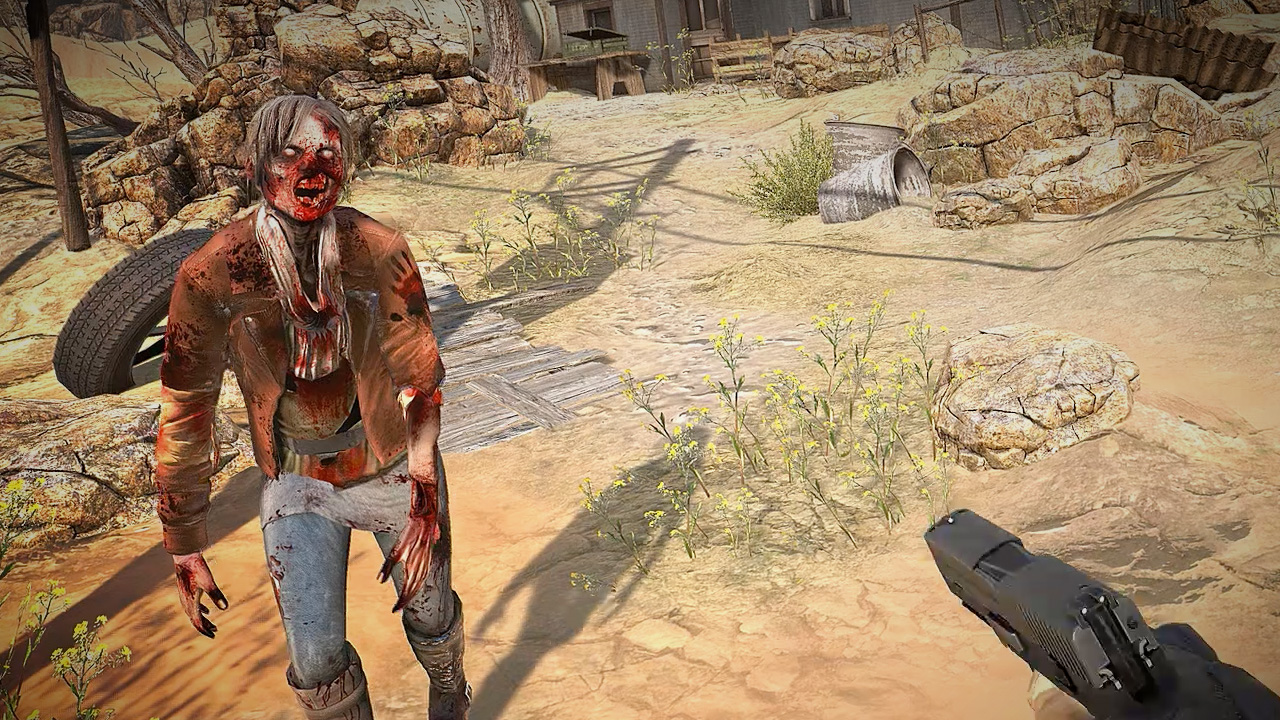
Arizona Sunshine
As the name might imply, Arizona Sunshine takes place in a virtual Arizona, and the game is largely sunny. What you might not get from the title, however, is that it’s a first-person zombie-killing shooter.
Developed by Vertigo Games and Jaywalkers Interactive, the game gave us pistols, shotguns, and machine guns to fight off waves of zombies, and yes, some of the zombies run. Once you clear out a wave of zombies, you can shoot at a point in front of you to teleport to the next part of the level. As we progressed through the stage, we would often encounter ammo crates that would allow us to sometimes pick up new guns and more ammunition. The game allows you to dual wield guns and you can mix and match. I preferred using a Deagle in my right hand (since I’m more accurate with my right hand) and a shotgun in my left hand for when I have to reload my Deagle and the zombies get close (with the shotgun, I don’t have to be as accurate). It's also worth noting that the game has an interesting reload mechanic: You're provided with a built-in ammo chest strap, so when your pistol runs out of bullets, you simply press a button to drop your old clip and press the butt of your gun into your chest to reload. It’s not quite realistic, but it makes for quick reloads and makes you feel like a complete badass when you’ve got it down.
While the game isn’t super scary, it did get a little more intense toward the end of the demo when we got to the mine shaft. I had to drop the shotgun in my left hand to pick up a flashlight, since it’s pretty much pitch black in there. Luckily, you won’t have to go at it alone because the devs told me that the game will support online co-op as well.
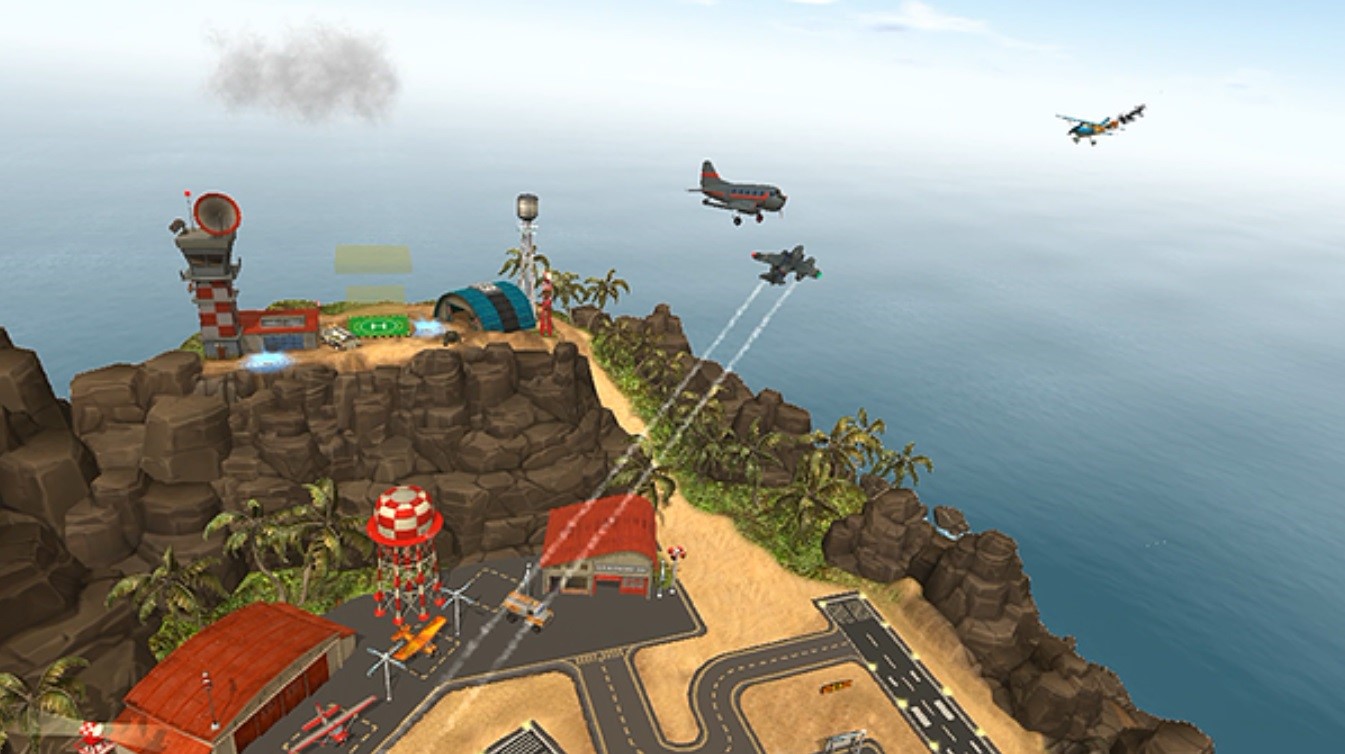
Final Approach
Out of all the games I tried out at the event, Final Approach might be the most unique. As a matter of fact, it’s even a little difficult to slot it into a genre. The closest would maybe be strategy or simulation, and the game was originally going to be a pilot management game, but it has evolved beyond that.
Basically, you can think of yourself as a god-like air traffic controller. With the controllers, you can reach out and select a little flying jet and then you’ll use the Vive's wand-like controller to draw out a linear pathway for it to follow toward a landing strip. The landing strip could be on land or on an aircraft carrier ship, depending on the level. You’ll have have to make sure that the lines you’re drawing aren’t too crazy, lest you risk crashing the jet. It’s with these simple constructs that the game makes you feel like a kid again, waving a little paper airplane around in the sky. It’s not all about directing the landings of jets, however. You’ll often have to command helicopters to pick up people for a rescue mission or sometimes you’ll have to get out of your god view to walk around the naval ship to put out a burning jet with a hose.
If any of this sounds intriguing to you, then rest easy knowing that you’ll be able to get your hands on it at launch.
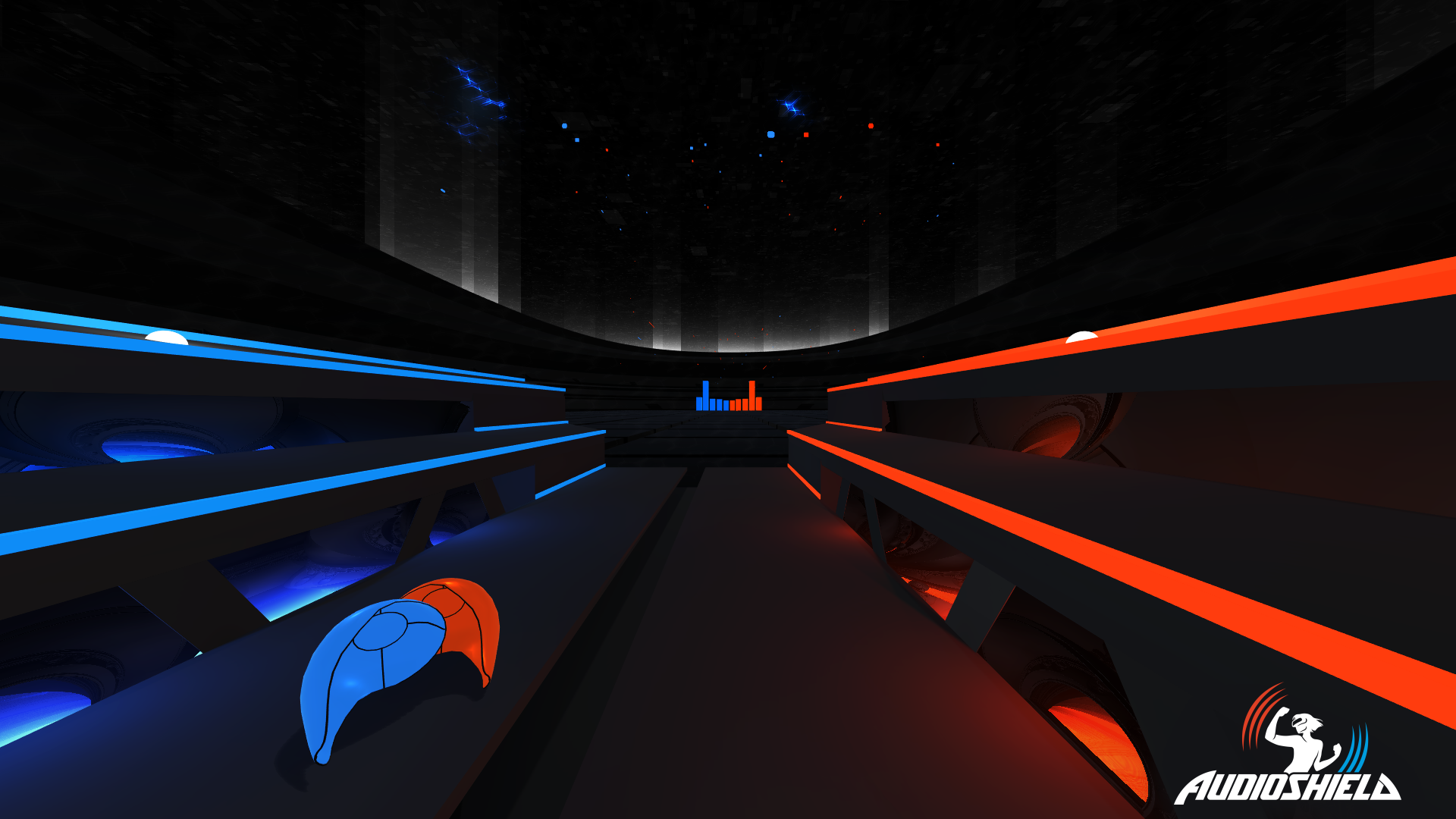
Audioshield
Developed by Dylan Fitterer, the creator behind the popular Audiosurf games, comes Audioshield. Like Audiosurf before it, Audioshield turns your library of songs into a rhythm game. What makes Audioshield different from its predecessors, however, is that you have to use two different colored shields to block wave of colored orbs catapulting down on you from the sky. In your left hand, you’ve got a blue shield, which can deflect blue orbs, and on the other hand, you’ve got an orange shield, which (you guessed it) deflects orange orbs. Occasionally, the song will get really intense and spit out purple orbs for you to deflect; here, you put both your shields together to form a purple shield to do the purple deflecting.
We got to play two songs, the first of which was M83’s "Midnight City." The song has a fantastic sci-fi pop beat, and as we deflected wave after wave of orbs coming at us, it felt like we were being pulled into a futuristic trance-like state with sparks of orange and blue splattering about. At times it was overwhelming, at other times it was euphoric. The second song we played was "Sabotage" by the Beastie Boys, which is just an aggressive cult classic. The game will also work with Soundcloud, in case your local library is limited.
If you were a fan of Audiosurf, you’ll love what Audioshield is doing here.
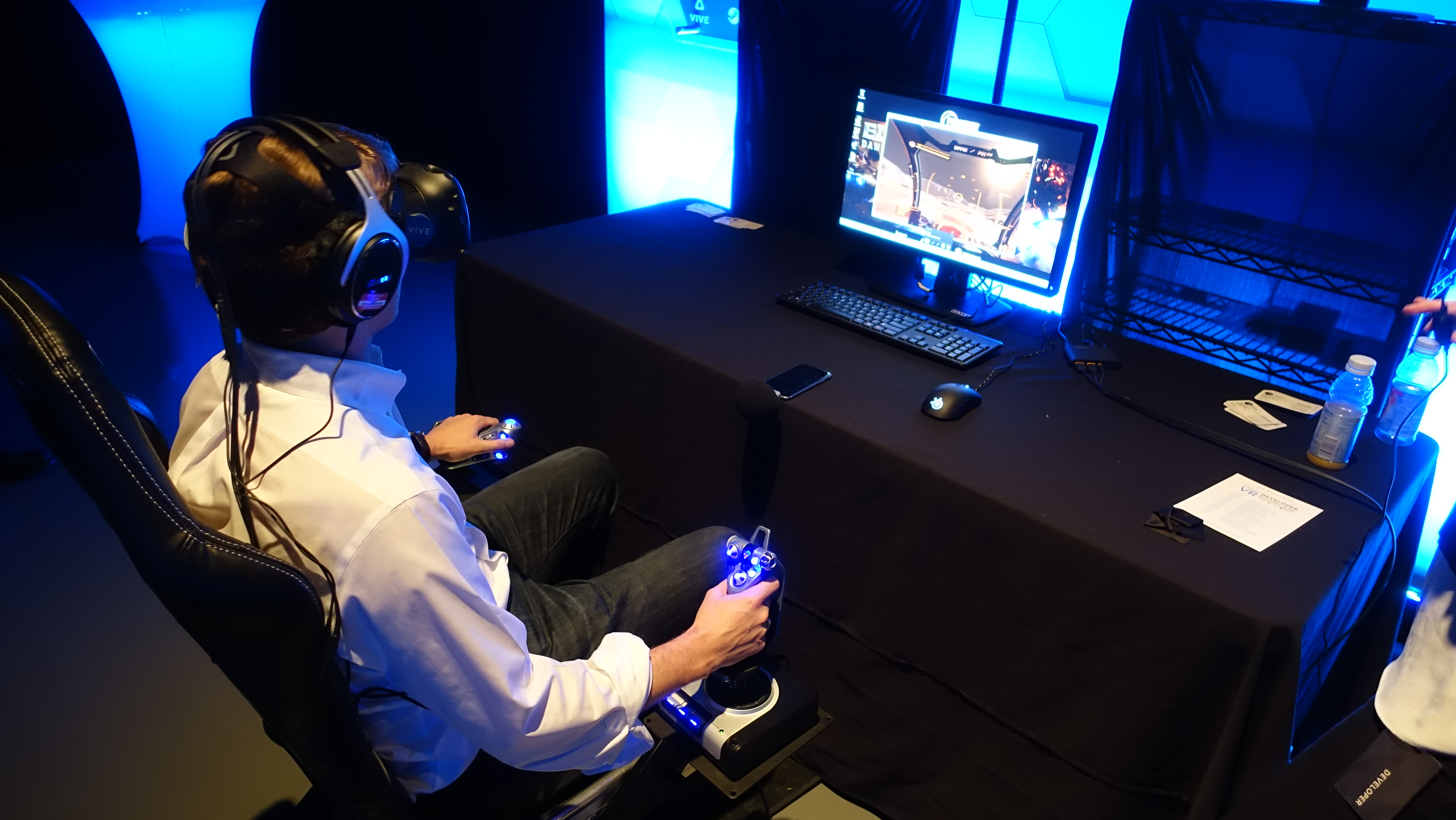
Elite Dangerous
Elite Dangerous is the only game we played that is technically available today. Hell, you can even play it in VR with the Oculus Rift DK2. We will say that it feels much better playing it with a HOTAS flight stick and the sharper Vive, however.
In case you’re unfamiliar with the game by Frontier Developments, it's a futuristic sci-fli flight simulator in the style of Wing Commander. The demo we played had us dogfighting it out with two computer AIs in space. It definitely makes tracking down your target much easier considering you can not only use your radar but look up and around your cockpit to locate your target.
As the game is out now, you can also expect to play it in VR on day one when the Vive ships.
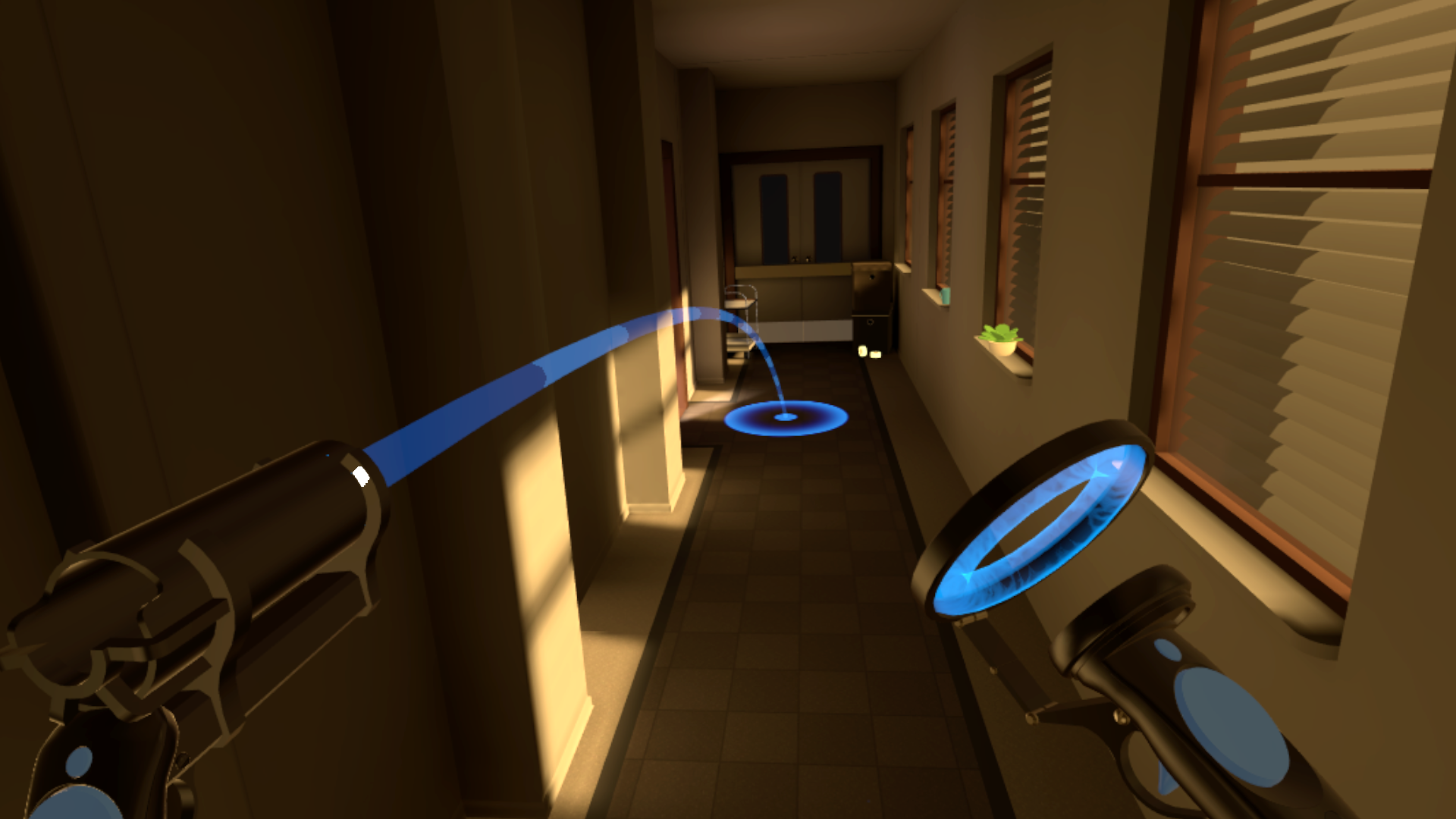
Budget Cuts
You might not guess it from the title, but Budget Cuts is a first-person stealth/puzzle-solving game. The premise is that you’re a spy with a limited budget, so you kind of have to Macgyver your way out of situations with the primitive gear that’s available within your environment. At times, it can feel like you’re playing one of those real-life “trapped in a room” puzzles that are all the rage now, except that you have to contend with walking robots that are out to get you.
Basically, you have to sneak around rooms and hallways undetected by these robots, but what really makes the game unique is the way you traverse the environment. In one way, the game is very similar to Portal in that you have a blaster that can shoot at where you’d like to teleport to. The caveat here is that you’ll need line of sight and there is an arc to your blast. This tool, coupled with the fact that you have to crouch/lean around corners to scope your environment, makes things extra tense, but fun.
Budget Cuts has a ton of potential, but won’t be shipping at the Vive’s launch, unfortunately.
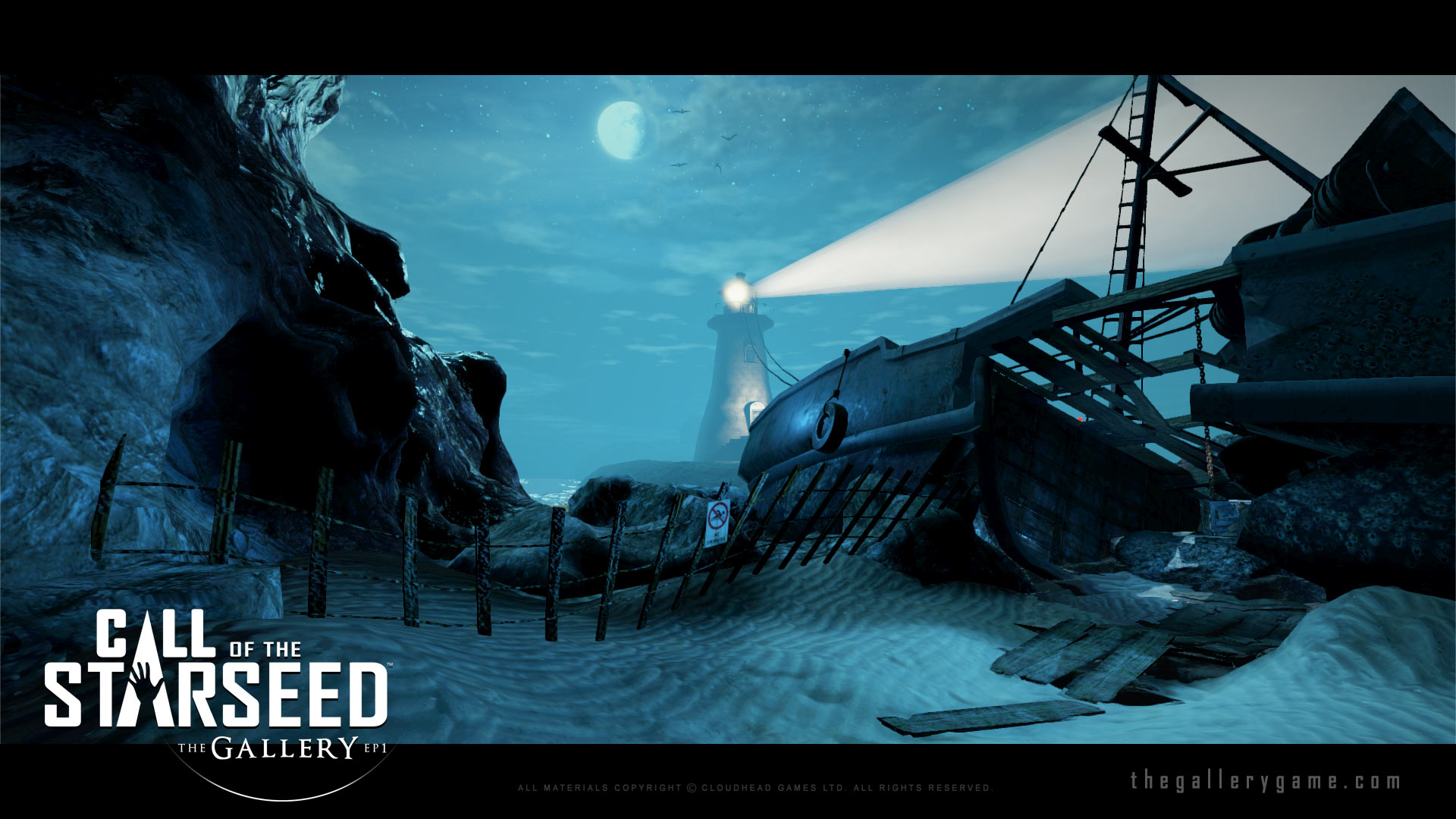
The Gallery: Call of the Starseed
Developed by Cloudhead Games, Call of the Starseed is the first episode of many in The Gallery. Each episode will take roughly two hours and bring you on a mystical and fantastical journey in search of your missing sister. The game is heavily influenced by fantasy films from the '80s, and while the second episode has you encountering magical creatures, this first episode is more grounded in reality.
In our demo, we explored a shipwreck by the sea and walked through some seaside caves. The game features a “blink” mechanic that allows you to more or less look at which direction you want to head in and teleport there with a press of a button. We got a very Dear Esther vibe from playing the game. We came across remnants of an abandoned campfire near the ocean, beer cans and bottles were strewn about, and there was a little propped-up tent we ducked into. A highlight of the episode was setting off fireworks that we found on the ground.
It’s seems like a much more somber tale, which is a bit refreshing considering most of the other titles we saw today were shooters or light-hearted goofy games.
The first episode will be available at the Vive’s launch.
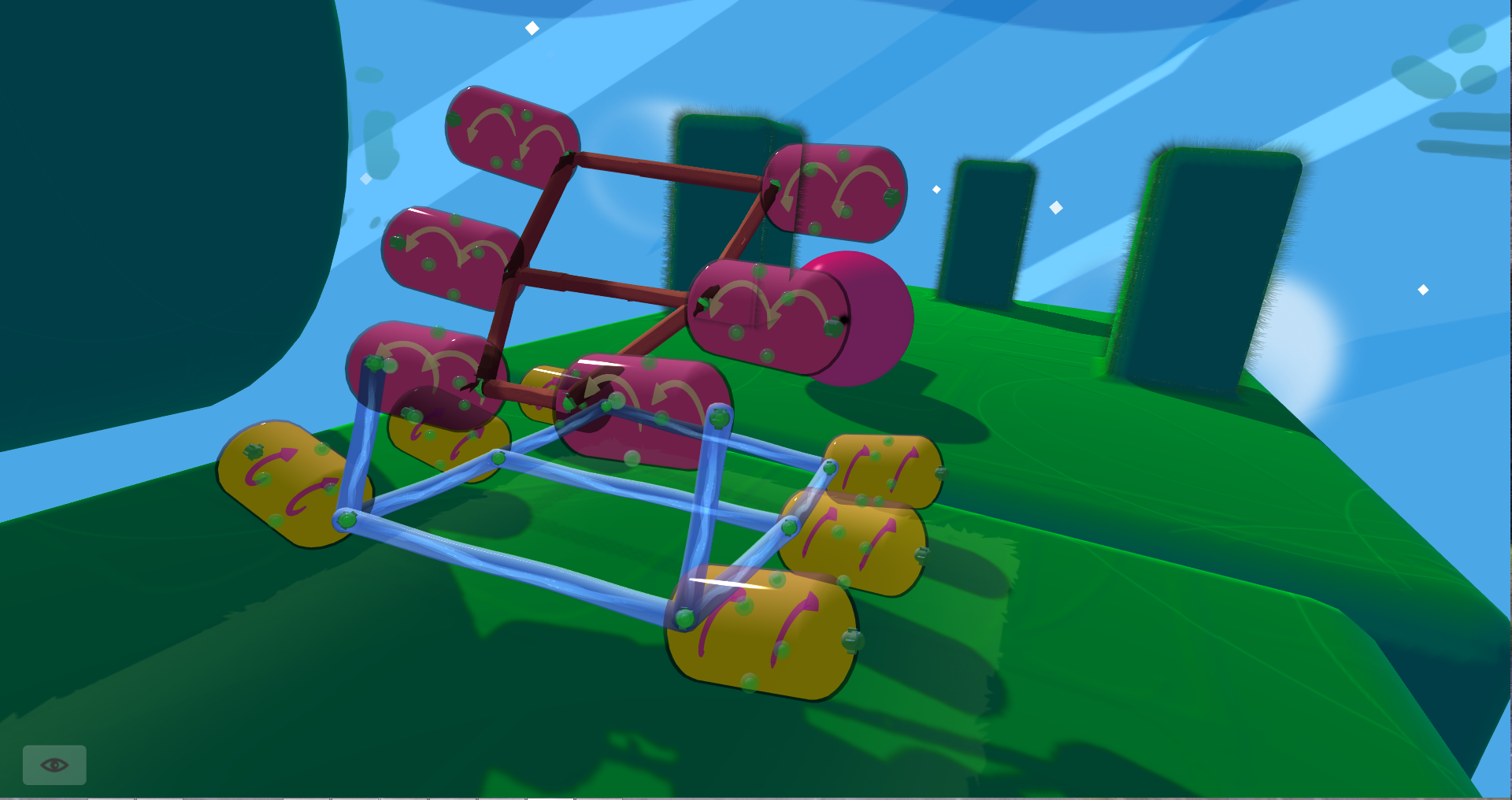
Fantastic Contraptions
As the name might imply, Fantastic Contraptions is a game about building, well, fantastic contraptions. Essentially, it’s a puzzle-solving game where you have to get an orb from one side of the level to another side of the level, and you’ll often do this by building vehicles with moving parts to transport it. There are spinning wheels and stretchable sticks to play with, and it’s sort of Poly Bridge had a baby with a Rube Goldberg machine, and it took a bunch of steroids. But it’s not only about building vehicles, you can also build catapults to launch the orb to the other side of the level. And speaking of levels, developer Radial Games is targeting around 100 levels at launch, which is just incredible. And yes, the game is set to launch when the Vive releases.

Conclusion
With the dozen games I played at the event, I can safely say Oculus VR has its work cut out in trying to come up with a stronger library of gaming launch titles. All the games are fun and/or promising in their own ways. And this isn’t including any potential games that Valve might be developing for the Vive in-house. And yes, we did ask them if they were planning to release any VR games in 2016, and no, they could neither confirm nor deny.
One thing that I'm certain about now more than ever, after playing around with the Vive all day, is that I think it’s a mistake for the Rift to not ship with the Touch controllers, however minor of an issue that might be moving forward. Both the Vive controllers and the Touch controllers are similarly awesome, and my concern is that with the Rift shipping with an Xbox controller first, it might fragment the market for the developers. Oculus says its shipping with an Xbox controller because game developers are used to it, but every single game developer that I asked today said they would rather the Oculus ship with the Touch controllers than without them (citing market fragmentation).
I realize the Rift is going for the mainstream crowd, but I can see my mother playing Cloudlands: VR Minigolf with no issues within five minutes, but there is no way that I can see her using an Xbox controller to play Lucky’s Tale.
Still, the VR wars, as it were, are just getting started and there’s still a lot that we don’t know about the Vive. We don’t know the price, for one. And Valve/HTC are also working on the final headset, which could have an integrated audio solution and improved ergonomics. (While the Vive isn’t heavy per se, it is heavier than the Rift.)
Still, as the saying goes, competition is good for the consumer in the long run, and if the Vive demos we saw are any indication of what’s to come, I’d say we’re in pretty good hands.


